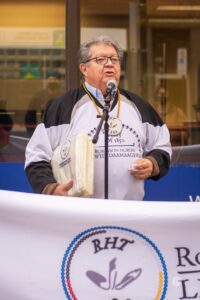Ontario blinks and negotiations begin in historic Robinson Huron Treaty trial

By Catherine Murton Stoehr
In a spectacular about face, Ontario has agreed to enter into negotiations with the Robinson Huron and Superior communities to determine a fair sharing of resources revenues from their territories. After decades, by some counts, centuries, of dismissal, refusal, and delay of the Robinson Huron and Superior communities’ demands for justice, Ontario and Canada have agreed to sit at a table and negotiate honourably with them.
A mere three months ago, the government of Ontario’s determination to defeat the Anishinabek’s claims to justice was plain for all to see when they took the extraordinary step of appealing decisions in the Anishinabek’s favour to the Supreme Court of Canada.
“We are pleased to be in a place where we are talking about negotiating a resolution to our annuities case outside of the court,” stated Batchewana First Nation Chief Dean Sayers in an announcement released the morning of Apr. 18. “We have always known that reconciliation will not happen in the courtroom.”
Details of the negotiations have not been released though further details and comments have been promised.
Hearings began in the case of Restoule v Canada, 2021 ONCA 779 [Restoule] in Thunder Bay in the fall of 2017. The case was brought against both the Nation of Canada and the Province of Ontario, and each level of government is represented by their own council and determines their own strategy. As of now, two of three planned trials have been completed with decisive findings in favour of the Robinson Huron and Superior communities. While the Government of Canada has indicated its willingness to negotiate, Ontario’s appeals have stood in the way.
The current litigation was born out of discussions by Robinson Huron leadership in the 1970s. The Union of Ontario Indians (now the Anishinabek Nation) began funding research into the claim until the Government of Canada disallowed the practice. The Lake Huron Region Chiefs then took up the daunting challenge themselves: finding funding for researchers, and lawyers, and all of the people needed to sustain this massive, complex action for decades.
Both the Federal Government and the Government of Ontario have strong motives to fight the Anishinabek’s claims in court. They are potentially in debt to the Anishinabek annuitants for 148 years of back payments, not to mention having to share all resource revenue profits going forward. Both levels of government have full-time lawyers and the historians who could sustain litigation indefinitely.
Time and reflection will clarify why Ontario blinked today, or why Canada became willing to negotiate when the findings against them started piling up. But a few things are clear.
The claim itself is valid. Hundreds of hours of testimony by the most knowledgeable people in the territory have confirmed that the signatories on both sides of the 1850 Treaty intended for annuities to rise in tandem with rising resource revenue profits.
The Robinson Huron Treaty Litigation Trust has succeeded in keeping both community members and non-Indigenous Canadians informed about and engaged with the lengthy process.
Growing numbers of non-Indigenous Canadians, made aware of Canada’s unfulfilled obligations to Indigenous Nations through the dauntless efforts of Indigenous artists, activists, politicians, and writers, can now conceive of the possibility that reconciliation might require real sacrifice, felt by regular citizens.
But none of this would have mattered if not for the determination of the people who have fought for this treaty. Determination that shone through every court hearing, announcement, Ceremony, Gathering, open letter, and opinion piece.
The Anishinabek are never, ever going to quit this fight.


